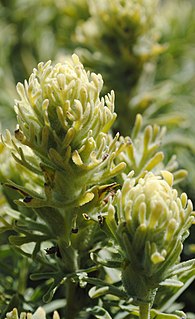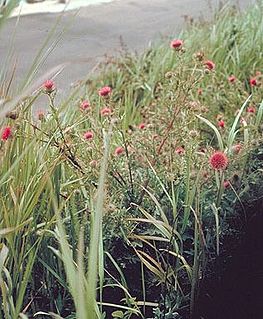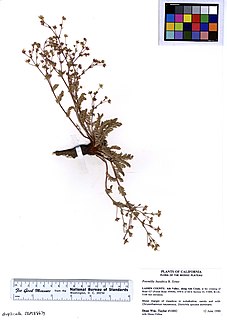Dendrosenecio johnstonii, formerly Senecio johnstonii, is a species of giant groundsel found in the middle altitudes of Mount Kilimanjaro in Africa. A recent botanical reclassification split off some species formerly in Senecio, putting the giant groundsels in the new genus Dendrosenecio. It also redefined the former species Senecio cottonii, as a subspecies of Dendrosenecio johnstonii. Both genera are in the family Asteraceae. The giant grounsels of the genus Dendrosenecio evolved, about a million years ago, from a Senecio that established itself on Mount Kilimanjaro, with those that survived adapting into Dendrosenecio kilimanjari. As it moved down the mountain, the adaptations necessary for the new environment created the new species, Dendrosenecio johnstonii. Various subspecies are found on other mountains.
Calyptridium parryi, synonym Cistanthe parryi, is a species of flowering plant in the family Montiaceae. It is known by the common name Parry's pussypaws. It is native to the southwestern United States and Baja California. It is a small annual herb producing spreading stems up to about 11 centimeters long. There is a basal rosette of small, thick, spoon-shaped leaves no more than about 3 centimeters long, with many along the stems as well. The inflorescence is a cluster a few centimeters wide, with each bearing three white petals surrounded by a few thin sepals. The fruit is a capsule less than a centimeter wide.

Castilleja grisea is a rare species of Indian paintbrush known by the common name San Clemente Island Indian paintbrush. It is endemic to San Clemente Island, one of the Channel Islands of California. San Clemente Island is owned by the US Navy so the Navy is involved in a management program to recover this species.

Ceanothus pinetorum is a species of shrub in the family Rhamnaceae known by the common names Kern ceanothus and Coville ceanothus. It is endemic to the Sierra Nevada of California, where it is known only from the Kern Plateau, a section of the southern Sierra featuring wide meadows and ridges.

Ceanothus verrucosus is a species of shrub in the family Rhamnaceae known by the common names wart-stem ceanothus, barranca brush, coast lilac and white coast ceanothus. It is endemic to northwestern Baja California and San Diego County, where it grows in coastal sage scrub and coastal succulent scrub habitats. It is considered a rare species north of the international border, as most of the valuable coastal land that hosts this plant in the San Diego area has been claimed for development. In California, several extant populations still remain scattered around the region, such as one protected at Torrey Pines.
Chaenactis alpigena is a species of flowering plant in the daisy family known by the common name southern Sierra pincushion. It is native to the High Sierra Nevada and the White Mountains of California, extending in the latter just into Nevada.
Chorizanthe diffusa is a species of flowering plant in the buckwheat family known by the common name diffuse spineflower. It is endemic to California, where it grows on the coastline and mountains of the Central Coast, in sandy scrub, woodland, and forest habitat. It is erect to prostrate in form, its stem generally no longer than 15 or 20 centimeters. The leaves are up to 2 centimeters long and mainly arranged about the base of the plant. The inflorescence is a cluster of flowers, each surrounded by six hook-tipped bracts. The margins of the bracts proximal to the long hooked tip may be very thin and nearly invisible to wide and obvious, and they may be green to white to purplish. The flower itself is about 3 millimeters wide and white with a yellow throat. The tips of its tepals may be smooth or jagged or toothed.
Chorizanthe wheeleri is a rare species of flowering plant in the buckwheat family known by the common names Santa Barbara spineflower and Wheeler's spineflower. It is endemic to Santa Cruz and Santa Rosa Islands, two of the Channel Islands of California.

Cirsium andrewsii is an uncommon species of thistle known by the common name Franciscan thistle. It is endemic to California, where it is known from the coastline of the San Francisco Bay Area from Marin to San Mateo Counties. There are also reports of isolated populations in the Klamath Mountains and in the Sierra Nevada.
Cirsium ciliolatum is a species of thistle known by the common name Ashland thistle. It is endemic to the Klamath Mountains, where it is known from only a few occurrences in Jackson and Josephine Counties in Oregon, as well as neighboring Humboldt and Siskiyou Counties in California. It is related to Cirsium undulatum and may be more accurately described as a variety of that species.

Clarkia virgata is a species of flowering plant in the evening primrose family known by the common name Sierra clarkia. It is endemic to California, where it is known from the forests and woodlands of the Sierra Nevada.

Chaenactis suffrutescens is a species of flowering plant in the aster family known by the common name Shasta chaenactis.
Diplacus johnstonii is a species of monkeyflower known by the common name Johnston's monkeyflower.
Potentilla rimicola is a species of cinquefoil-Potentilla, known by the common name cliff cinquefoil.

Rorippa subumbellata is a rare species of flowering plant in the family Brassicaceae known by the common names Lake Tahoe yellowcress and Tahoe yellow cress. It is known only from the shores of Lake Tahoe, straddling the border between California and Nevada. There are an estimated fourteen populations of the plant still in existence. It grows only on the direct shoreline of the lake, occupying a seven-foot semi-aquatic zone between the high- and low-tide marks. It is directly impacted by recreational activities on the lake, enduring bombardment by boat wakes, trampling, and construction of docks and other structures.

Potentilla villosa is a species of flowering plant in the rose family, Rosaceae. Its common names include villous cinquefoil, northern cinquefoil, and hairy cinquefoil. It is native to northwestern North America, where its distribution extends from Alaska to Alberta to Oregon. There are records from eastern Asia.
Potentilla cottamii is a rare species of flowering plant in the rose family known by the common names Cottam's cinquefoil and Pilot Range cinquefoil. It is native to Nevada and Utah in the United States. It occurs in the Pilot Range of Elko County, Nevada, and a small area of adjacent Utah.
Primula capillaris is a rare species of flowering plant in the primrose family known by the common name Ruby Mountains primrose, or Ruby Mountain primrose. It is endemic to Nevada in the United States, where it is limited to the Ruby Mountains of Elko County.

Potentilla basaltica is a species of flowering plant in the rose family known by the common names Soldier Meadows cinquefoil and basalt cinquefoil. It is endemic to a small area of the Modoc Plateau and Warner Mountains in northeastern California and northwestern Nevada.
Castilleja kerryana is a species of flowering plant in the family Orobanchaceae. It is commonly known as Kerry's Indian paintbrush or Kerry’spaintbrush. It was formally described in 2013 and so far it is known only from a small population in the state of Montana, in the Northwestern United States.









